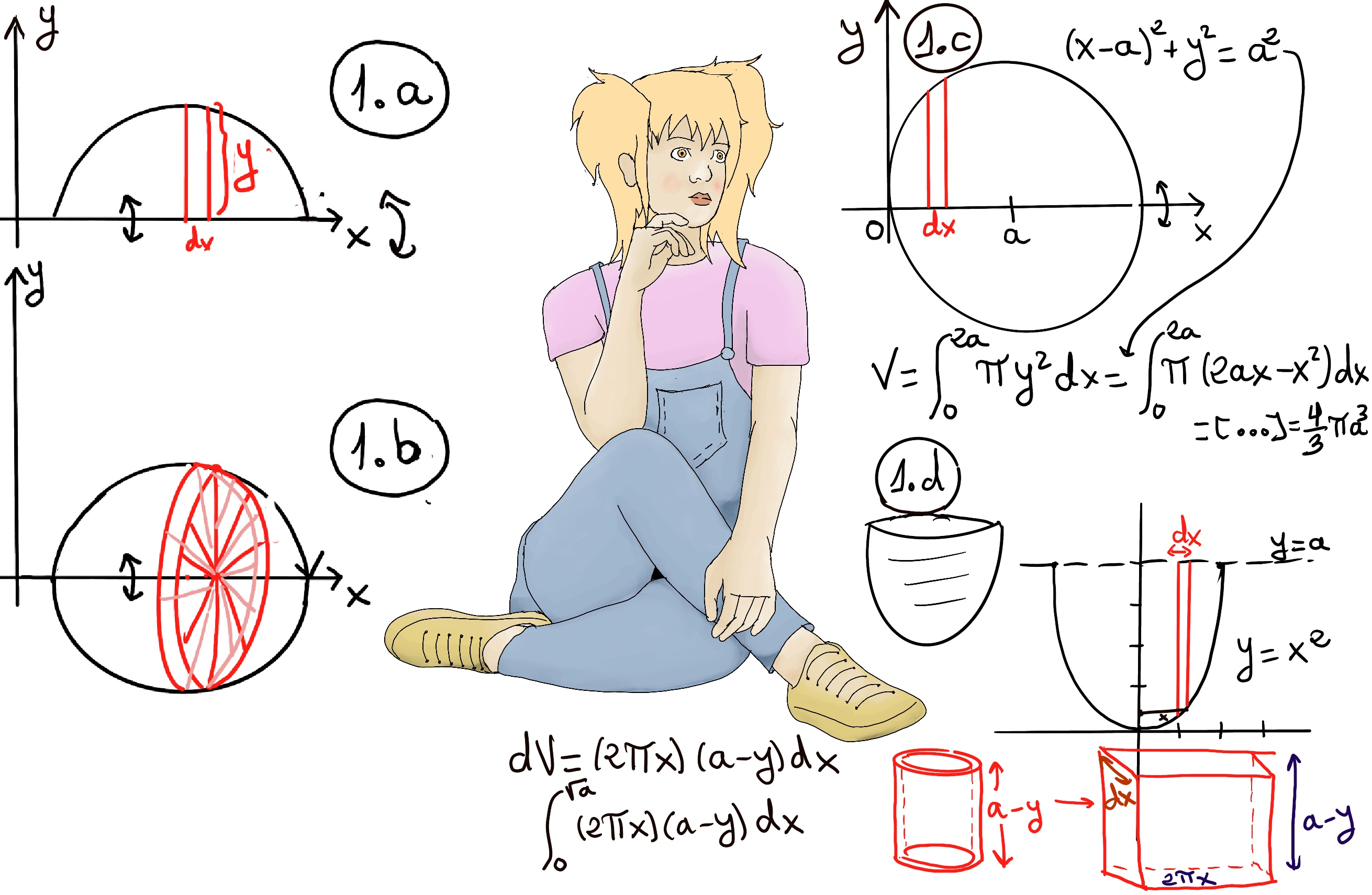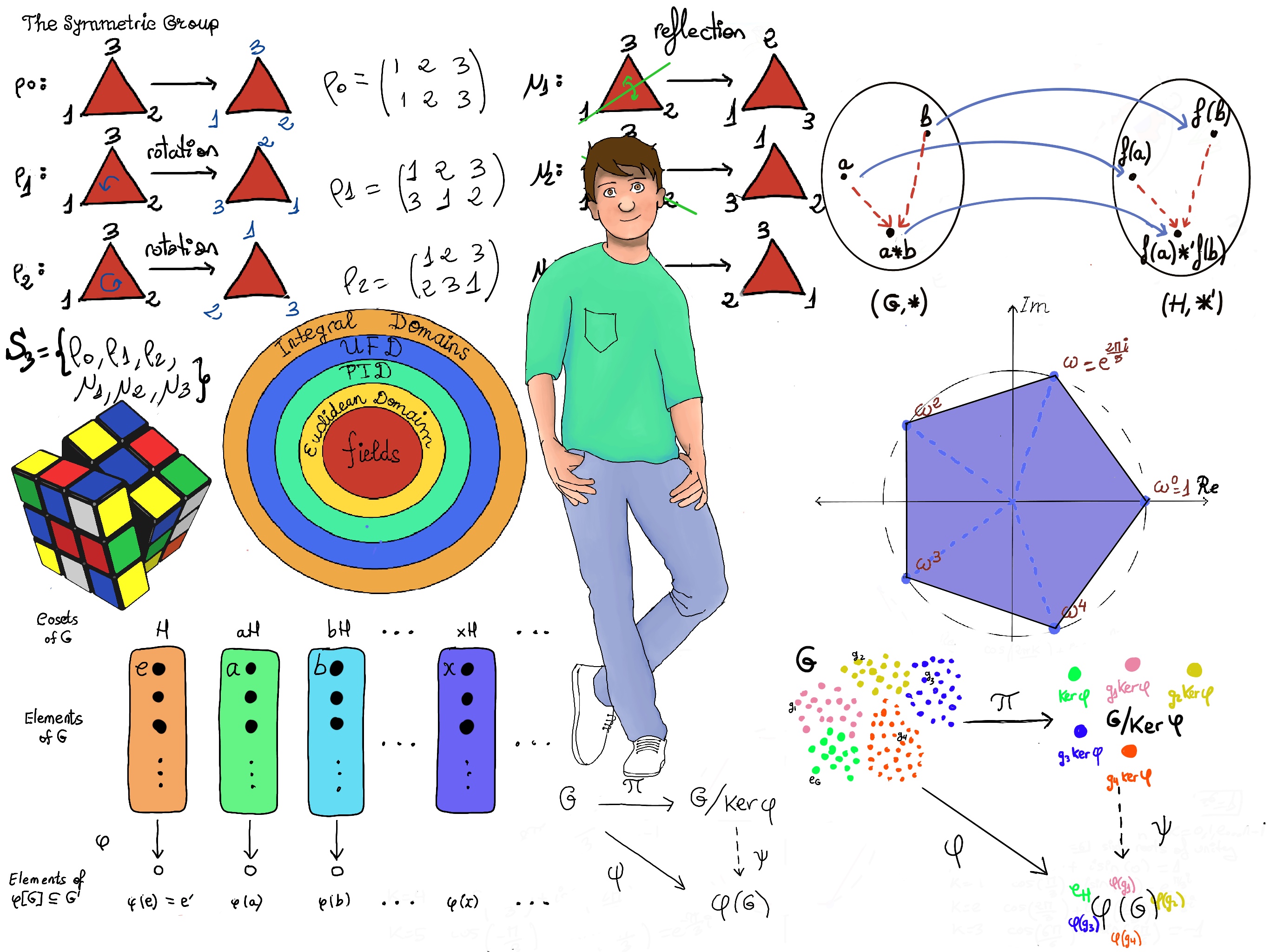
|
 |
 |

|
 |
 |
“If you hear a voice within you say ‘you cannot paint’, then by all means paint and that voice will be silenced,” Vincent van Gogh.
Antiderivatives are fundamental concepts in calculus. They are the inverse operation of derivatives.
Given a function f(x), an antiderivative, also known as indefinite integral, F, is the function that can be differentiated to obtain the original function, that is, F’ = f, e.g., 3x2 -1 is the antiderivative of x3 -x +7 because $\frac{d}{dx} (x^3-x+7) = 3x^2 -1$. Symbolically, we write F(x) = $\int f(x)dx$.
The process of finding antiderivatives is called integration.
The Fundamental Theorem of Calculus states roughly that the integral of a function f over an interval is equal to the change of any antiderivate F (F'(x) = f(x)) between the ends of the interval, i.e., $\int_{a}^{b} f(x)dx = F(b)-F(a)=F(x) \bigg|_{a}^{b}$.
The fundamental theorem of calculus can be rewritten or expressed as follows. If f is a continuously differentiable function on [a, b] with derivative f′, then $f(b)-f(a) = \int_{a}^{b} f’(x)dx$, that is, the definite integral of the rate of change of a function on [a, b] is the total change of the function itself on [a, b].
$\frac{f(b)-f(a)}{b-a} = \frac{\int_{a}^{b} f’(x)dx}{b-a}$ where the left side of this equation is just the average of the function f over the interval [a, b].
Denoting the velocity as v(t), Average_Velocity = $\frac{s(b)-s(a)}{b-a} = \frac{1}{b-a} \int_{a}^{b} v(t)dt = \frac{1}{b-a} \int_{a}^{b} s’(t)dt$ (if y = s(t) represents the position function, then v = s′(t) represents the instantaneous velocity).
If f is a function that is continuous on [a,b] and differentiable on (a,b), then there is at least one point c ∈ [a, b] such that $f(c) = \frac{1}{b-a}\int_{a}^{b} f(x)d(x)$ . Futhermore, since f is continuous on [a, b], by the Extreme Value Theorem, there exist m and m such that m ≤ f(x) ≤ M, and so m(b-a) ≤ $\int_{a}^{b} f(x)d(x)$ ≤ M(b -a).
Proof.
f is continuous over an interval [a, b] ⇒[By the Extreme Value Theorem] there exist m and m such that m ≤ f(x) ≤ M ∀ x∈ [a, b] ⇒[Comparison Theorem] m(b-a) ≤ $\int_{a}^{b} f(x)d(x)$ ≤ M(b -a) ⇒ m ≤ $\frac{1}{b-a}\int_{a}^{b} f(x)d(x)$ ≤ M.
Since $\frac{1}{b-a}\int_{a}^{b} f(x)d(x)$ ∈ [m, M], f is continuous and assumes the values m and M over [a, b] ⇒[By the Intermediate Value Theorem] there is a number c over [a, b] such that $f(c) = \frac{1}{b-a}\int_{a}^{b} f(x)d(x)$.
Suppose F’(x) = $\frac{1}{1+x}, F(0) = 1$, the MVT implies A < F(4) < B, could you compute A and B?
By Intermediate Value Theorem (f is continuous on the closed interval [a, b] and differentiable on the open interval (a, b) ⇒ ∃c ∈ (a, b) such that f’(c) is equal to the function’s average rate of change over [a, b]), F(4) - F(0) = F’(c)(4 -0) = $\frac{1}{1+c}·4$ ⇒[c ∈ (0, 4)] $\frac{1}{1+4}·4 < \frac{1}{1+c}·4 < \frac{1}{1+0}·4 ⇒ \frac{4}{5} < F(4) - F(0) < 4 ⇒ \frac{4}{5} < F(4) - 1 < 4 ⇒ \frac{9}{5} < F(4) < 5$, hence A = 9/5, and B = 5.
Similarly, it could be argued by the Fundamental Theorem of Calculus, F(4) -F(0) = $\int_{0}^{4} \frac{dx}{1+x}dx <[x = 0] \int_{0}^{4} dx = 4$ -this is the red rectangle, Figure 1.a.-. On the other hand, F(4) -F(0) = $\int_{0}^{4} \frac{dx}{1+x}dx >[x = 4] \int_{1}^{5} \frac{1}{5}dx = \frac{4}{5}$ -this is the yellow rectangle below, Figure 1.a.-, and we obtain the same result.
Find the average value of the function f(x) = 8 -2x over the interval [0, 4] and find c such that f(c) equals this value.
The average value of the function over [0, 4] = $\frac{1}{4-0}\int_{0}^{4} (8-2x)dx = \frac{1}{4}·(8x-x^2)\bigg|_{0}^{4} = \frac{1}{4}·(8·4-16) = 4$. Next, we are going to set this average value to f(c) and solve for c, 8 -2c = 4 ⇒ c = 2.

The Second Fundamental Theorem of Calculus. If f is a continuous function and c is a constant, then f has a unique antiderivative A that satisfies A(c) = 0, and that antiderivative is given by the rule A(x) = $\int_{c}^{x} f(t)dt$.
Proof.
A’(x) = $\lim_{h \to 0} \frac{A(x+h)-A(x)}{h} = \lim_{h \to 0} \frac{\int_{c}^{x+h} f(t)dt-\int_{c}^{x} f(t)dt}{h}$ =[Integrating Definite Integral Backwards] $\lim_{h \to 0} \frac{\int_{c}^{x+h} f(t)dt+\int_{x}^{c} f(t)dt}{h}$ =[Definite Integrals on Adjacent Intervals] $\lim_{h \to 0} \frac{\int_{x}^{x+h} f(t)dt}{h}$ =🚀
Now, observe that for very small values of h, $\int_{x}^{x+h} f(t)dt ≈ f(x)·h$ by a simple left-hand approximation of the integral.
$\lim_{h \to 0} \frac{\int_{x}^{x+h} f(t)dt}{h}$ =🚀 = $\lim_{h \to 0} \frac{f(x)·h}{h} = f(x)$∎
The reader should notice that A(x) solves the differential equation y’ = f, with the initial condition y(c) = 0 ($\int_{c}^{c} f(t)dt = 0$). If we differentiate A’(x) = $\lim_{\Delta x \to 0}\frac{\Delta A}{\Delta x} = f(x)$ -By assumption, f is continuous-.
$\frac{d}{dx} \int_{1}^{x} \frac{dt}{t^2}$. Notice that A(x) = $\int_{c}^{x} \frac{dt}{t^2} = \int_{c}^{x} f(t)dt$ where f(t) = $\frac{1}{t^2}$, c = 1, and by the previous result, A’(x) = f(x), that is, $\frac{d}{dx} \int_{1}^{x} \frac{dt}{t^2} = \frac{1}{x^2}$.
Let’s check our previous result. $\int_{1}^{x} \frac{dt}{t^2} = \int_{1}^{x} t^{-2} = -t^{-1}\bigg|_{1}^{x} = -\frac{1}{x}-(-1) = 1 -\frac{1}{x} = A(x)$
⇒ $\frac{d}{dx}A(x) = \frac{d}{dx}(1 -\frac{1}{x}) = \frac{1}{x^2}$∎ ⇒ A is an antiderivative of f, and since A(1) = $\int_{1}^{1} f(t)dt = 0$, A is the only antiderivative of f for which A(1) = 0.
$\frac{d}{dx} \int_{2}^{x} (cos(t) -t)dt$. Notice that A(x) = $\int_{2}^{x} (cos(t) -t)dt$ where f(x) = cos(t) -t and c = 2, and by the previous result A’(x) = f(x), that is, $\frac{d}{dx} \int_{2}^{x} (cos(t) -t)dt = cos(x)-x.$
Let’s check our previous result. $\int_{2}^{x} (cos(t) -t)dt = sin(t) -\frac{1}{2}t^2\bigg|_{2}^{x} = sin(x)-\frac{1}{2}x^2-(sin(2)-2)= A(x)$
⇒ $\frac{d}{dx}A(x) = cos(x)-x$ ∎ ⇒ A is an antiderivative of f, and since A(2) = $\int_{2}^{2} f(t)dt = 0$, A is the only antiderivative of f for which A(2) = 0.
$\frac{d}{dx} \int_{1}^{\sqrt{x}} sin(t)dt$ =[$u(x)=\sqrt{x}, F(x)=\int_{1}^{u(x)} sin(t)d(t) = G∘u, G(x)=\int_{1}^{x} sin(t)d(t)$]. By the The Second Fundamental Theorem of Calculus and the Chain Rules, $\frac{d}{dx} \int_{1}^{\sqrt{x}} sin(t)dt = sin(u(x))·\frac{du}{dx} = sin(u(x))·(\frac{1}{2}x^{\frac{-1}{2}}) = \frac{sin(\sqrt{x})}{2\sqrt{x}}$

The Fundamental Theorem of Calculus. If f is continuous over the interval [a, b], and F is any antiderivate, then $\int_{a}^{b} f(x)dx = F(b)-F(a)=F(x) \bigg|_{a}^{b}$, i.e., the integral of a function f over an interval is equal to the change of any antiderivate F (F’(x) = f(x)) between the ends of the interval.
Proof.
Let’s F be an antiderivate, F’ = f, and let’s define G(x) = $\int_{a}^{x} f(t)dt$. By the Fundamental Theorem of Calculus, G’(x) = f(x) ⇒[F’ = f] F’(x) = G’(x) ⇒ (F -G)’ = F’ - G’ = f -f = 0 ⇒ F(x) = G(x) + c where c is a constant.
Therefore, F(b) - F(a) =[F(x) = G(x) + c] (G(b) + c) - (G(a) + c) = G(b) -G(a) = $\int_{a}^{b} f(x)dx -\int_{a}^{a} f(t)dt = \int_{a}^{b} f(x)dx$ ∎